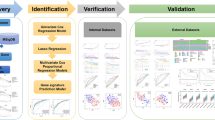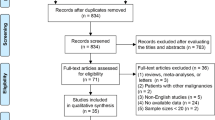Abstract
Hepatocellular carcinoma (HCC) represents the sixth most frequent human cancer worldwide and is characterized by rapid progression as well as resistance to systemic chemotherapy. Recently, glycolysis has emerged as a potent driving force of tumor growth and therapy failure. The precise role of glycolysis for the pathogenesis of human HCC has not been elucidated thus far. Therefore, we have conducted a comprehensive analysis of the expression patterns of central glycolysis-related factors [glucose transporter-1 and -2 (Glut-1 and Glut-2), phosphoglycerate kinase-1 (PGK-1) and hypoxia-inducible factor-1α (HIF-1α)] in a large cohort of benign and malignant human liver samples. PGK-1 protein and gene expression was scant in normal liver, elevated in cirrhotic livers and most intense in HCC. Strong immunoreactivity of Glut-2 was noted in cirrhotic livers, whereas in HCC it was only expressed in 50% of examined cases. Strikingly, PGK-1 as well as Glut-2 protein expression was indicative of poor patient prognosis. Glut-1 protein was absent in neoplastic hepatocytes but prominent in tumor-associated endothelial cells. Specific nuclear staining of HIF-1α was noted in only 12% of HCC samples. Our data point toward a tumor-promoting function of glycolysis in HCC and establish PGK-1 as an independent prognostic parameter. Furthermore, the endothelial-specific expression of Glut-1 makes a special dependence of vessels on glucose reasonable to assume. In summary, we believe our analysis warrants the validation of glycolytic inhibitors as innovative treatment approaches of human HCC.






Similar content being viewed by others
References
Abbey CK, Borowsky AD, Gregg JP, Cardiff RD, Cherry SR (2006) Preclinical imaging of mammary intraepithelial neoplasia with positron emission tomography. J Mammary Gland Biol Neoplasia 11:137–149
Avila MA, Berasain C, Sangro B, Prieto J (2006) New therapies for hepatocellular carcinoma. Oncogene 25:3866–3884
Bosch FX, Ribes J, Diaz M, Cleries R (2004) Primary liver cancer: worldwide incidence and trends. Gastroenterology 127:S5–S16
Bosch FX, Ribes J, Cleries R, Diaz M (2005) Epidemiology of hepatocellular carcinoma. Clin Liver Dis 9:191–211, v
Chen G, Gharib TG, Wang H, Huang CC, Kuick R, Thomas DG, Shedden KA, Misek DE, Taylor JM, Giordano TJ, Kardia SL, Iannettoni MD, Yee J, Hogg PJ, Orringer MB, Hanash SM, Beer DG (2003) Protein profiles associated with survival in lung adenocarcinoma. Proc Natl Acad Sci USA 100:13537–13542
DeBerardinis RJ, Lum JJ, Hatzivassiliou G, Thompson CB (2008) The biology of cancer: metabolic reprogramming fuels cell growth and proliferation. Cell Metab 7:11–20
El-Serag HB, Mason AC (1999) Rising incidence of hepatocellular carcinoma in the United States. N Engl J Med 340:745–750
Fantin VR, St-Pierre J, Leder P (2006) Attenuation of LDH-A expression uncovers a link between glycolysis, mitochondrial physiology, and tumor maintenance. Cancer Cell 9:425–434
Galluzzi L, Kepp O, Tajeddine N, Kroemer G (2008) Disruption of the hexokinase-VDAC complex for tumor therapy. Oncogene 27:4633–4635
Gatenby RA, Gillies RJ (2004) Why do cancers have high aerobic glycolysis? Nat Rev Cancer 4:891–899
Gatenby RA, Gillies RJ (2007) Glycolysis in cancer: a potential target for therapy. Int J Biochem Cell Biol 39:1358–1366
Gatenby RA, Gawlinski ET, Gmitro AF, Kaylor B, Gillies RJ (2006) Acid-mediated tumor invasion: a multidisciplinary study. Cancer Res 66:5216–5223
Godoy A, Ulloa V, Rodriguez F, Reinicke K, Yanez AJ, Garcia ML, Medina RA, Carrasco M, Barberis S, Castro T, Martinez F, Koch X, Vera JC, Poblete MT, Figueroa CD, Peruzzo B, Perez F, Nualart F (2006) Differential subcellular distribution of glucose transporters GLUT1–6 and GLUT9 in human cancer: ultrastructural localization of GLUT1 and GLUT5 in breast tumor tissues. J Cell Physiol 207:614–627
Grimmer C, Balbus N, Lang U, Aigner T, Cramer T, Muller L, Swoboda B, Pfander D (2006) Regulation of type II collagen synthesis during osteoarthritis by prolyl-4-hydroxylases: possible influence of low oxygen levels. Am J Pathol 169:491–502
Grobholz R, Hacker HJ, Thorens B, Bannasch P (1993) Reduction in the expression of glucose transporter protein GLUT 2 in preneoplastic and neoplastic hepatic lesions and reexpression of GLUT 1 in late stages of hepatocarcinogenesis. Cancer Res 53:4204–4211
Hwang TL, Liang Y, Chien KY, Yu JS (2006) Overexpression and elevated serum levels of phosphoglycerate kinase 1 in pancreatic ductal adenocarcinoma. Proteomics 6:2259–2272
International Union Against Cancer (UICC) (2003) TNM Klassifikation maligner Tumoren. Springer, Heidelberg
Jin S, DiPaola RS, Mathew R, White E (2007) Metabolic catastrophe as a means to cancer cell death. J Cell Sci 120:379–383
Kim KR, Moon HE, Kim KW (2002) Hypoxia-induced angiogenesis in human hepatocellular carcinoma. J Mol Med 80:703–714
Kondoh H, Lleonart ME, Bernard D, Gil J (2007) Protection from oxidative stress by enhanced glycolysis; a possible mechanism of cellular immortalization. Histol Histopathol 22:85–90
Lay AJ, Jiang XM, Kisker O, Flynn E, Underwood A, Condron R, Hogg PJ (2000) Phosphoglycerate kinase acts in tumour angiogenesis as a disulphide reductase. Nature 408:869–873
Lee JD, Yang WI, Park YN, Kim KS, Choi JS, Yun M, Ko D, Kim TS, Cho AE, Kim HM, Han KH, Im SS, Ahn YH, Choi CW, Park JH (2005) Different glucose uptake and glycolytic mechanisms between hepatocellular carcinoma and intrahepatic mass-forming cholangiocarcinoma with increased (18)F-FDG uptake. J Nucl Med 46:1753–1759
Marrero JA (2006) Hepatocellular carcinoma. Curr Opin Gastroenterol 22:248–253
Mazurek S, Grimm H, Boschek CB, Vaupel P, Eigenbrodt E (2002) Pyruvate kinase type M2: a crossroad in the tumor metabolome. Br J Nutr 87(Suppl 1):S23–S29
Paudyal B, Oriuchi N, Paudyal P, Tsushima Y, Iida Y, Higuchi T, Hanaoka H, Miyakubo M, Takano A, Ishikita T, Endo K (2007) Early diagnosis of recurrent hepatocellular carcinoma with 18F-FDG PET after radiofrequency ablation therapy. Oncol Rep 18:1469–1473
Paudyal B, Oriuchi N, Paudyal P, Higuchi T, Nakajima T, Endo K (2008a) Expression of glucose transporters and hexokinase II in cholangiocellular carcinoma compared using [18F]-2-fluro-2-deoxy-d-glucose positron emission tomography. Cancer Sci 99:260–266
Paudyal B, Paudyal P, Oriuchi N, Tsushima Y, Nakajima T, Endo K (2008b) Clinical implication of glucose transport and metabolism evaluated by 18F-FDG PET in hepatocellular carcinoma. Int J Oncol 33:1047–1054
Pfander D, Cramer T, Swoboda B (2005) Hypoxia and HIF-1alpha in osteoarthritis. Int Orthop 29:6–9
Popanda O, Fox G, Thielmann HW (1998) Modulation of DNA polymerases alpha, delta and epsilon by lactate dehydrogenase and 3-phosphoglycerate kinase. Biochim Biophys Acta 1397:102–117
Rohwer N, Lobitz S, Daskalow K, Jons T, Vieth M, Schlag PM, Kemmner W, Wiedenmann B, Cramer T, Hocker M (2009) HIF-1alpha determines the metastatic potential of gastric cancer cells. Br J Cancer 100:772–781
Scheepers A, Joost HG, Schurmann A (2004) The glucose transporter families SGLT and GLUT: molecular basis of normal and aberrant function. JPEN J Parenter Enteral Nutr 28:364–371
Semenza GL (2007) Hypoxia-inducible factor 1 (HIF-1) pathway. Sci STKE 2007:cm8
Semenza GL, Roth PH, Fang HM, Wang GL (1994) Transcriptional regulation of genes encoding glycolytic enzymes by hypoxia-inducible factor 1. J Biol Chem 269:23757–23763
St. Croix B, Rago C, Velculescu V, Traverso G, Romans KE, Montgomery E, Lal A, Riggins GJ, Lengauer C, Vogelstein B, Kinzler KW (2000) Genes expressed in human tumor endothelium. Science 289:1197–1202
Swietach P, Vaughan-Jones RD, Harris AL (2007) Regulation of tumor pH and the role of carbonic anhydrase 9. Cancer Metastasis Rev 26:299–310
Tanaka Y, Hanada K, Mizokami M, Yeo AE, Shih JW, Gojobori T, Alter HJ (2002) Inaugural article: a comparison of the molecular clock of hepatitis C virus in the United States and Japan predicts that hepatocellular carcinoma incidence in the United States will increase over the next two decades. Proc Natl Acad Sci USA 99:15584–15589
Vaupel P, Mayer A (2007) Hypoxia in cancer: significance and impact on clinical outcome. Cancer Metastasis Rev 26:225–239
Warburg O (1956) On the origin of cancer cells. Science 123:309–314
WHO Classification of Tumours (2000) Pathology and genetics: tumours of the digestive system. IARC Press, Lyon
Xu HX, Xie XY, Lu MD, Liu GJ, Xu ZF, Zheng YL, Liang JY, Chen LD (2007) Contrast-enhanced sonography in the diagnosis of small hepatocellular carcinoma ≤2 cm. J Clin Ultrasound 36:257–266
Yamamoto T, Seino Y, Fukumoto H, Koh G, Yano H, Inagaki N, Yamada Y, Inoue K, Manabe T, Imura H (1990) Over-expression of facilitative glucose transporter genes in human cancer. Biochem Biophys Res Commun 170:223–230
Yasuda S, Fujii H, Nakahara T, Nishiumi N, Takahashi W, Ide M, Shohtsu A (2001) 18F-FDG PET detection of colonic adenomas. J Nucl Med 42:989–992
Yasuda S, Arii S, Mori A, Isobe N, Yang W, Oe H, Fujimoto A, Yonenaga Y, Sakashita H, Imamura M (2004) Hexokinase II and VEGF expression in liver tumors: correlation with hypoxia-inducible factor 1 alpha and its significance. J Hepatol 40:117–123
Zimmerman RL, Fogt F, Burke M, Murakata LA (2002) Assessment of Glut-1 expression in cholangiocarcinoma, benign biliary lesions and hepatocellular carcinoma. Oncol Rep 9:689–692
Acknowledgments
This study was supported by grants from the Deutsche Forschungsgemeinschaft (CR 133/2-2) and the Berliner Krebsgesellschaft (CRFF200804) to Thorsten Cramer. Nadine Rohwer was supported by grants from the Deutsche Forschungsgemeinschaft (Graduiertenkolleg 276/4). The excellent technical assistance of Birgit Bogdanoff is highly appreciated.
Author information
Authors and Affiliations
Corresponding author
Additional information
Christoph Benckert and Thorsten Cramer have contributed equally to this work.
Rights and permissions
About this article
Cite this article
Daskalow, K., Pfander, D., Weichert, W. et al. Distinct temporospatial expression patterns of glycolysis-related proteins in human hepatocellular carcinoma. Histochem Cell Biol 132, 21–31 (2009). https://doi.org/10.1007/s00418-009-0590-4
Accepted:
Published:
Issue Date:
DOI: https://doi.org/10.1007/s00418-009-0590-4




